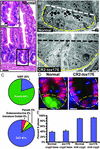Molecular features of adult mouse small intestinal epithelial progenitors
- PMID: 12552106
- PMCID: PMC298716
- DOI: 10.1073/pnas.242735899
Molecular features of adult mouse small intestinal epithelial progenitors
Abstract
The adult mouse small intestinal epithelium undergoes perpetual regeneration, fueled by a population of multipotential stem cells and oligopotential daughters located at the base of crypts of Lieberkühn. Although the morphologic features of small intestinal epithelial progenitors (SiEPs) are known, their molecular features are poorly defined. Previous impediments to purification and molecular characterization of SiEPs include lack of ex vivo clonigenic assays and the difficulty of physically retrieving them from their niche where they are interspersed between their numerous differentiated Paneth cell daughters. To overcome these obstacles, we used germ-free transgenic mice lacking Paneth cells to obtain a consolidated population of SiEPs with normal proliferative activity. These cells were harvested by laser capture microdissection. Functional genomics analysis identified 163 transcripts enriched in SiEPs compared with Paneth cell-dominated normal crypt base epithelium. The dataset was validated by (i) correlation with the organellar composition of SiEPs versus Paneth cells, (ii) similarities to databases generated from recent mouse hematopoietic and neural stem cell genome anatomy projects, and (iii) laser capture microdissectionreal-time quantitative RT-PCR studies of progenitor cell-containing populations retrieved from the small intestines, colons, and stomachs of conventionally raised mice. The SiEP profile has prominent representation of genes involved in c-myc signaling and in the processing, localization, and translation of mRNAs. This dataset, together with our recent analysis of gene expression in the gastric stem cell niche, discloses a set of molecular features shared by adult mouse gut epithelial progenitors.
Figures




References
Publication types
MeSH terms
Substances
Grants and funding
LinkOut - more resources
Full Text Sources
Other Literature Sources
Medical
Molecular Biology Databases

